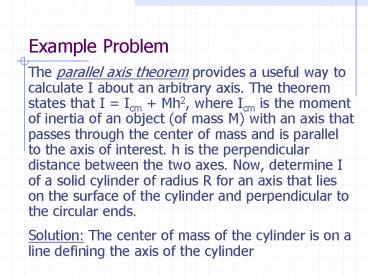Example Problem PowerPoint PPT Presentation
Title: Example Problem
1
Example Problem
The parallel axis theorem provides a useful way
to calculate I about an arbitrary axis. The
theorem states that I Icm Mh2, where Icm is
the moment of inertia of an object (of mass M)
with an axis that passes through the center of
mass and is parallel to the axis of interest. h
is the perpendicular distance between the two
axes. Now, determine I of a solid cylinder of
radius R for an axis that lies on the surface of
the cylinder and perpendicular to the circular
ends. Solution The center of mass of the
cylinder is on a line defining the axis of the
cylinder
2
R
cm
From Table 10.2 From the parallel axis theorem
with hR Apply to thin rod
L/2
L
3
Rotational Work
- For translational motion, we defined the work
as - For rotational motion
r
s
?
r
s arc length r?
FT
Units of N m or J when ? is in radians
Rotational Kinetic Energy
- For translational motion, the KE was defined
4
- For a point particle I mr2, therefore
- Or for a rigid body
- For a rigid body that has both translational and
rotational motion, its total kinetic energy
is - The total mechanical energy is then
5
Example
A car is moving with a speed of 27.0 m/s. Each
wheel has a radius of 0.300 m and a moment of
inertia of 0.850 kg m2. The car has a total mass
(including the wheels) of 1.20x103 kg. Find (a)
the translational K of the entire car, (b) the
total KR of the four wheels, and (c) the total K
of the car. Solution Given vcar 27.0 m/s,
mcar 1.20x103 kg, rw 0.300 m, Iw 0.850 kg
m2
6
a)
b)
c)
7
Example Problem
A tennis ball, starting from rest, rolls down a
hill into a valley. At the top of the valley, the
ball becomes airborne, leaving at an angle of 35
with respect to the horizontal. Treat the ball as
a thin-walled spherical shell and determine the
horizontal distance the ball travels after
becoming airborne.
0
3
1.8 m
?
1
2
4
x
8
Solution Given v0 0, ?0 0, y0 1.8 m h,
y1 y2 y4 0, ?2 35, x2 0,
I(2/3)MR2 Find x4 ? Method As there is no
friction or air resistance in the problem,
therefore no non-conservative forces, we can use
conservation of mechanical energy
9
Velocity of ball equals tangential velocity at
edge of ball
Now, use 2D kinematic equations for projectile
motion
10
v2
v4
PowerShow.com is a leading presentation sharing website. It has millions of presentations already uploaded and available with 1,000s more being uploaded by its users every day. Whatever your area of interest, here you’ll be able to find and view presentations you’ll love and possibly download. And, best of all, it is completely free and easy to use.
You might even have a presentation you’d like to share with others. If so, just upload it to PowerShow.com. We’ll convert it to an HTML5 slideshow that includes all the media types you’ve already added: audio, video, music, pictures, animations and transition effects. Then you can share it with your target audience as well as PowerShow.com’s millions of monthly visitors. And, again, it’s all free.
About the Developers
PowerShow.com is brought to you by CrystalGraphics, the award-winning developer and market-leading publisher of rich-media enhancement products for presentations. Our product offerings include millions of PowerPoint templates, diagrams, animated 3D characters and more.

